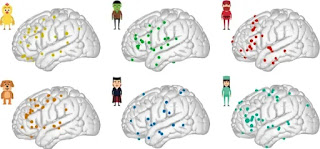Therefore is the name of it called Babel; because the LORD did there confound the language of all the earth: and from thence did the LORD scatter them abroad upon the face of all the earth. Genesis 11:9
--Sounds like there were 2 major Linguistic groups who stayed around Babel----the Sumerian and Semetic Akkadian groups.--Sumerian would be a LANGUAGE ISOLATE because it didn't disperse and morph through dialects as fast a Akkadian. Likely there were more Akkadian speakers and spread out and multiplied faster and farther with the result of it's dialects morphing into Semetic sub-branches.
--Another observation is that since Sumer is considered the first organized civilization with first written language (likely because those who stayed behind at Babel had the cultural structure to build upon immediately) it would sense it was used later as a nostalgic language of a "old period".
"The Sumerian language was spoken in southern Mesopotamia and was the first language to be written in the cuneiform script. It is an isolate language meaning we know of no other languages that relate to it ancestrally.
The language was spoken in a region where Semitic languages were also
spoken, particularly Akkadian, and it eventually fell out of use in
favor of those languages.
Little is known about when Sumerian-speaking people arrived in southern
Mesopotamia, assuming they did not originate there. Either way, from a
very early period a multilingual environment existed in southern
Mesopotamia, which included languages like Sumerian, an early form of
Akkadian, other Semitic languages, and Hurrian.
Some scholars have
posited the possibility of an otherwise unknown substrate, or
influencing language of the area, due to the presence of words of
unknown origin in Sumerian writings.
Even though these texts are difficult to read, we can ascertain literary
themes like
--the formation of the world,
--divine temple building,
--and
other divine activities, sometimes of an adult nature.
In these texts,
we also encounter a large number of names of scribes and functions which
are Akkadian in origin, suggesting that the two languages were very
intermixed, as stated above. This was the time of the Sumerian's
greatest worldly influence, as evidenced by texts outside the
Mesopotamian realm from Mari, Ebla, Tell Beydar, and Tell Brak which utilized the cuneiform script for Sumerian as well as their local Semitic languages.
The writing system of Sumerian has the principles of polyphony and
homophony.
Polyphony means that some signs have multiple syllabic
values, for instance the DU sign could be read either 'du', 'ra2', 'ša4',
etc., each having different but often related meanings.
Homophony means
that there are multiple signs having the same syllabic value. You may
have noticed the use of subscripts (2) in the sign values.
This is because syllables like 'ra' had multiple sign renderings like RA
, the aforementioned DU, and others. Incredibly, some syllables had
more than 10 different signs representing them.
This principle of homophony and the fact that one syllable in
Sumerian often comprises the entire word have led some scholars to
believe that Sumerian contained a tonal system.
Eme-sal is commonly referred to as a dialect of Sumerian as opposed to eme-gir15
or the “main dialect” of Sumerian. The writing of eme-sal is limited to
ritual texts, particularly the lamentation texts for gala-priests, and
the words spoken by certain goddesses, although in other places these
goddesses speak eme-gir15.
Because the sign SAL can have a
reading as munus meaning “woman”, scholars have posited that eme-sal is a
genderlect or special dialect for speech by women.
However, the sign SAL also has the reading sal which means “thin” or
“soft” and could simply refer to a special variant for the goddesses or
ritual-performing priests as stated before. Another suggestion put forth
is that the gala-priests were eunuchs, but there is no evidence for
castration in ancient southern Mesopotamian culture.
Sumerian language enjoyed a resurrection during the Old Babylonian
period as a literary and liturgical language. The scribes in this period
considered the language as essential for maintaining the traditions of a
very old period, and wanted to recapture an archaic
time of magic and legend. After this period ending c. 1595 BC, the
scribal usage of Sumerian decreased significantly. The repertoire of
texts was reduced, particularly the royal/divine hymns of the Ur III
period, and even the ones that continued were written only in bilingual
renditions with Akkadian and other languages.
However, Sumerian was
still being studied in scribal schools and even chanted in liturgy
through the Persian and Hellenistic periods. There even exist student exercise tablets with cuneiform on one side and Greek on the other.
The last known cuneiform tablet was an astronomical work dating to 75 AD from Babylon, but it is possible that the script finally fell out of use later than this." WHE





.jpg)
.jpg)


.jpg)



















